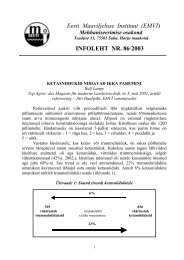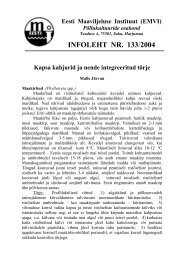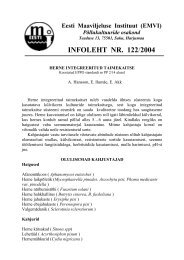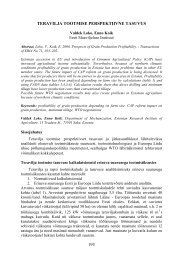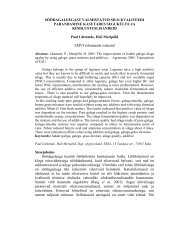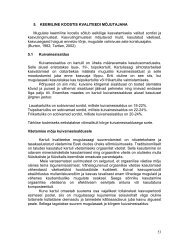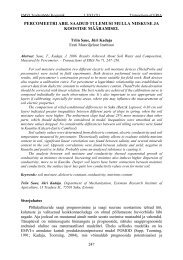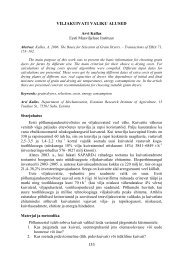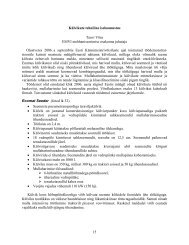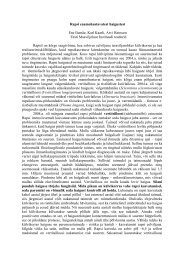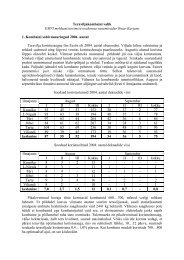Possibilities of growing Camelina sativa in ecological cultivation
Possibilities of growing Camelina sativa in ecological cultivation
Possibilities of growing Camelina sativa in ecological cultivation
Create successful ePaper yourself
Turn your PDF publications into a flip-book with our unique Google optimized e-Paper software.
extent. Contam<strong>in</strong>ation by Phoma l<strong>in</strong>gam, Cyl<strong>in</strong>drosporium concentricum andMycosphaerella brassicicola is unimportant. Engag<strong>in</strong>g <strong>Camel<strong>in</strong>a</strong> <strong>in</strong> crop rotation and <strong>in</strong> case<strong>of</strong> frequent <strong>grow<strong>in</strong>g</strong> the danger <strong>of</strong> diseases and pests <strong>in</strong>creases.<strong>Camel<strong>in</strong>a</strong> oil is be<strong>in</strong>g used mostly for <strong>in</strong>dustrial purpose: by good energetic characteristics itis well suitable for mak<strong>in</strong>g biodiesel fuel. For mak<strong>in</strong>g pa<strong>in</strong>ts and l<strong>in</strong>oleum it is be<strong>in</strong>g usedtogether with other plant oils. It is also used for mak<strong>in</strong>g green soap. Some parts <strong>of</strong> oil and oilfreemeal composition (eicosenoic and erucic acid, glucos<strong>in</strong>olates) restrict its use for humanfood and animal feed. In late years its development work has achieved good results <strong>in</strong>elim<strong>in</strong>at<strong>in</strong>g eicosenoic acid content. The use <strong>of</strong> <strong>Camel<strong>in</strong>a</strong> oil is limited by high content <strong>of</strong>unsaturated fatt<strong>in</strong>g acids although the oil conta<strong>in</strong>s several natural protection means aga<strong>in</strong>stoxidis<strong>in</strong>g – antioxidants- e.g. toc<strong>of</strong>erol. The fatty acid consistence <strong>of</strong> <strong>Camel<strong>in</strong>a</strong> oil is shown<strong>in</strong> table 1 (Makowski, 2003). The high consistence <strong>of</strong> l<strong>in</strong>olenic and eicosenoic acid makes thetaste unsatisfactory.Table 1 Fatty acid composition <strong>of</strong> <strong>Camel<strong>in</strong>a</strong> and spr<strong>in</strong>g rape<strong>Camel<strong>in</strong>a</strong>Average In Trials Spr<strong>in</strong>g rape(ERIA)Oil content 35…40 36…37 40…45Palmitic (C16:0) 5…8 6.07 3…6Stearic (C18:0) 2…3 2.54 1…3Oleic (C18:1) 13…21 13.2 55…65L<strong>in</strong>oleic (18:2) 15…20 20.8 20…25L<strong>in</strong>olenic (18:3) 30…40 35.5 6…14Eicosenoic (20:1) 13…20 12,35 0…2Erucic (22:1) 3…4 3.6 0…2<strong>Camel<strong>in</strong>a</strong> <strong>grow<strong>in</strong>g</strong> is generally carried out accord<strong>in</strong>g to the same pr<strong>in</strong>ciples as <strong>grow<strong>in</strong>g</strong> rape.Perfect soil tillage together with plough<strong>in</strong>g has to guarantee weed control. Pre-sow<strong>in</strong>g soiltillage favours germ<strong>in</strong>ation <strong>of</strong> weed seeds and the shoots are damaged <strong>in</strong> the last pre-sow<strong>in</strong>gtillage. S<strong>in</strong>ce the seed is small, it is especially essential to form the good seed basisguarantee<strong>in</strong>g low sow<strong>in</strong>g and soil moisture. Pre-sow<strong>in</strong>g roll<strong>in</strong>g tightens the soil loosened bycultivat<strong>in</strong>g-harrow<strong>in</strong>g. The soil be<strong>in</strong>g rolled must not be wet. For early sow<strong>in</strong>g the soil tillagehas to be started possibly early. Clover should be used <strong>in</strong> <strong>ecological</strong> crop rotation whichenriches the soil with biologically fixed air-nitrogen guarantee<strong>in</strong>g <strong>Camel<strong>in</strong>a</strong> the neededamount <strong>of</strong> N <strong>in</strong> soil. Clover is an essential crop <strong>in</strong> the control <strong>of</strong> perennial weeds. Therecommended sow<strong>in</strong>g time is together with cereals sow<strong>in</strong>g or immediately after that.<strong>Camel<strong>in</strong>a</strong> comes up fast, earlier than essential weeds. Relatively high density <strong>of</strong> plant per m 2and narrow-rowed sow<strong>in</strong>g are important primarily for fight<strong>in</strong>g with annual weeds. Due torapid primary development <strong>Camel<strong>in</strong>a</strong> suppresses annual weeds. Individually grown <strong>Camel<strong>in</strong>a</strong>plants are not competitive with weeds; <strong>Camel<strong>in</strong>a</strong> cannot compete with perennial weeds,either. In <strong>ecological</strong> production trial the harrow<strong>in</strong>g <strong>of</strong> pea and <strong>Camel<strong>in</strong>a</strong> mixture damaged<strong>Camel<strong>in</strong>a</strong> plants and the mixed sow<strong>in</strong>g rema<strong>in</strong>ed sparse.In the trial carried out <strong>in</strong> the Estonian Research Institute <strong>of</strong> Agriculture the rates <strong>of</strong> 4.0 kgha -1 (400 germ<strong>in</strong>at<strong>in</strong>g seeds per m 2 ) <strong>in</strong> a pure stand and <strong>in</strong> the mixtures with the pea ’Majoret’3.0 kg ha -1 (300 germ.seeds per m 2 ) were applied. The average humus content <strong>of</strong> soil was 3,0%, P 102 mg kg -1 and K 182 mg kg -1 . The field trials were situated on soddy-calcareous soil,preced<strong>in</strong>g crop was spr<strong>in</strong>g barley. It was sown with a narrow row space. Grow<strong>in</strong>g the mixture<strong>of</strong> pea and <strong>Camel<strong>in</strong>a</strong> the pea fixes the air-nitrogen <strong>in</strong> the soil additionally (60 kg ha -1 ), whichcovers the growth-time need <strong>of</strong> nitrogen for <strong>Camel<strong>in</strong>a</strong>. <strong>Camel<strong>in</strong>a</strong> is a good support<strong>in</strong>g crop2



